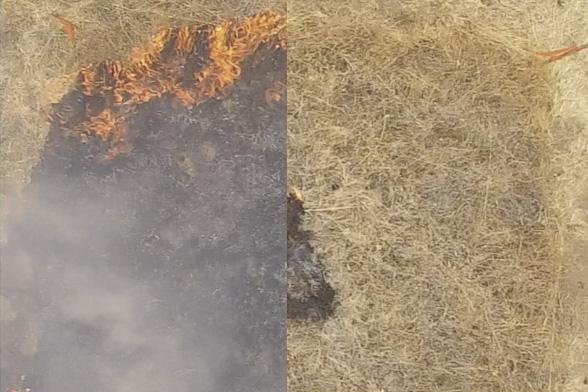The plot on the right was coated with a new flame retardant, preventing the spread of fire. The untreated plot of grass on the left was quickly engulfed by the flames. Photo by Eric Appel/Stanford
Oct. 1 (UPI) -- Tree stands in fire-prone forests could soon get some relief. Scientists at Stanford University have developed a gel-like liquid that acts as a flame retardant.
Researchers suggest the material could be used to protect vulnerable trees in wildfire-prone areas, as well as reduce the frequency and severity of wildfires more broadly.
Scientists described the material's potential this week in the journal PNAS.
"This has the potential to make wildland firefighting much more proactive, rather than reactive," senior study author Eric Appel, an assistant professor of materials science and engineering in the Stanford School of Engineering, said in a news release. "What we do now is monitor wildfire-prone areas and wait with bated breath for fires to start, then rush to put them out."
Global warming and a century of heavy-handed fire suppression has left much of the American West hot, dry and dense with flammable vegetation and prone to intense wildfires. The 2019 fire season was relatively low-key, but the prior two seasons featured a handful of record-setting fires.
Many ecosystems rely on periodic fires, but today, most wildfires are human-caused and, for the reasons stated above, prone to quickly spread and grow out of control.
Retardants are typically used to stop the spread of fires from starting or spreading, and they usually feature ammonium phosphate or its derivatives. But most retardants don't last very long, limiting their preventative abilities.
Suppressants are used to control active fires. These gel-like substances carry water and superabsorbent polymers, but they lose their fire-fighting powers once the water evaporates.
The new retardant developed by Stanford scientists, a cellulose-based gel-like fluid, is long-lasting. The environmentally benign gel remains on vegetation through wind and rain.
"You can put 20,000 gallons of this on an area for prevention, or 1 million gallons of the traditional formulation after a fire starts," said lead study author Anthony Yu, a doctoral student in materials science and engineering at Stanford.
In field tests, scientists applied the gel to grass and chamise, a type of shrub where wildfires often start. The retardant successfully prevented fires from sparking, even after a half-inch of rain.
"We hope these new materials can open the door to identifying and treating high-risk areas to protect people's lives and livelihoods," said Alan Peters, a division chief with the California Department of Forestry and Fire Protection in San Luis Obispo.















